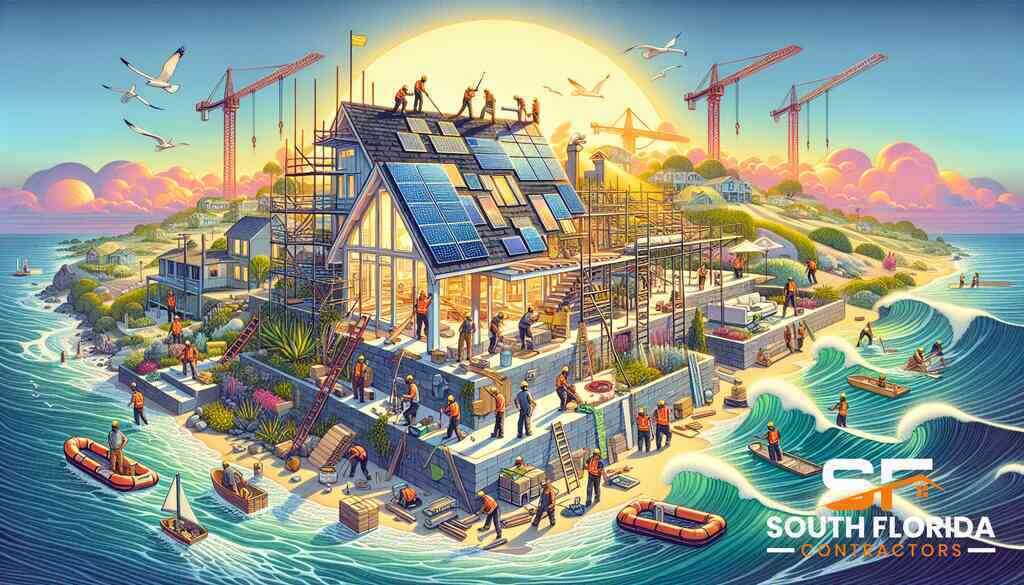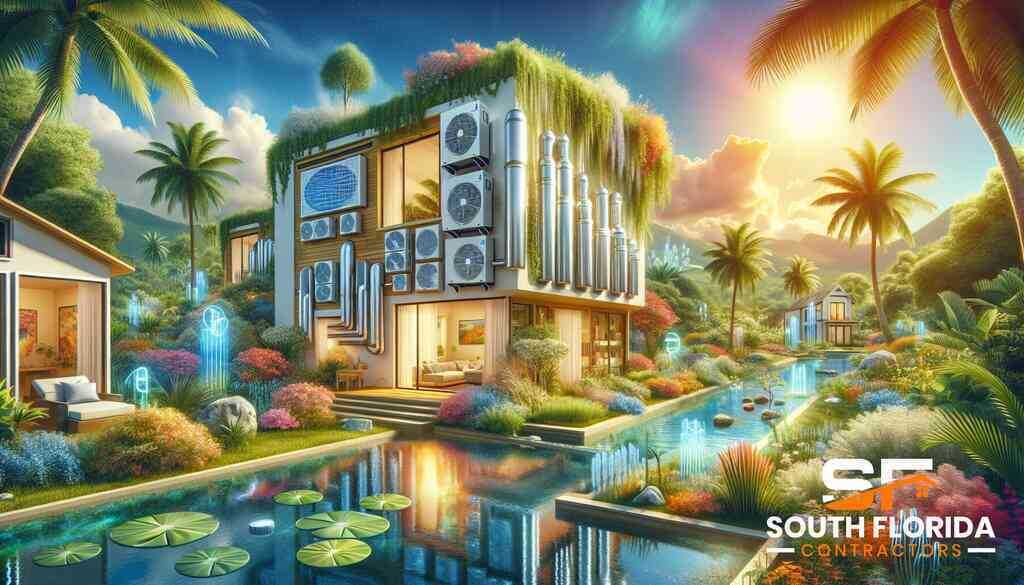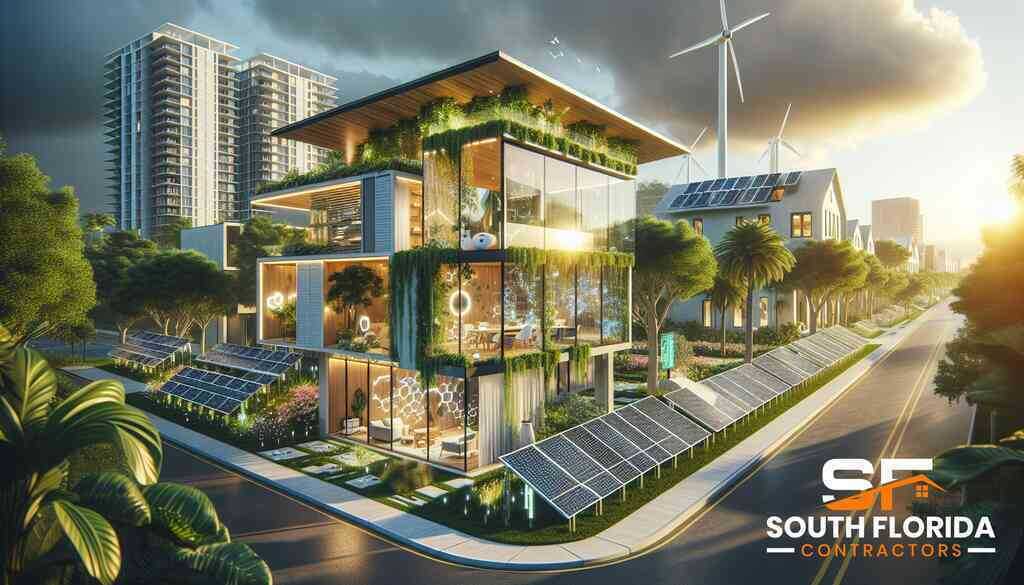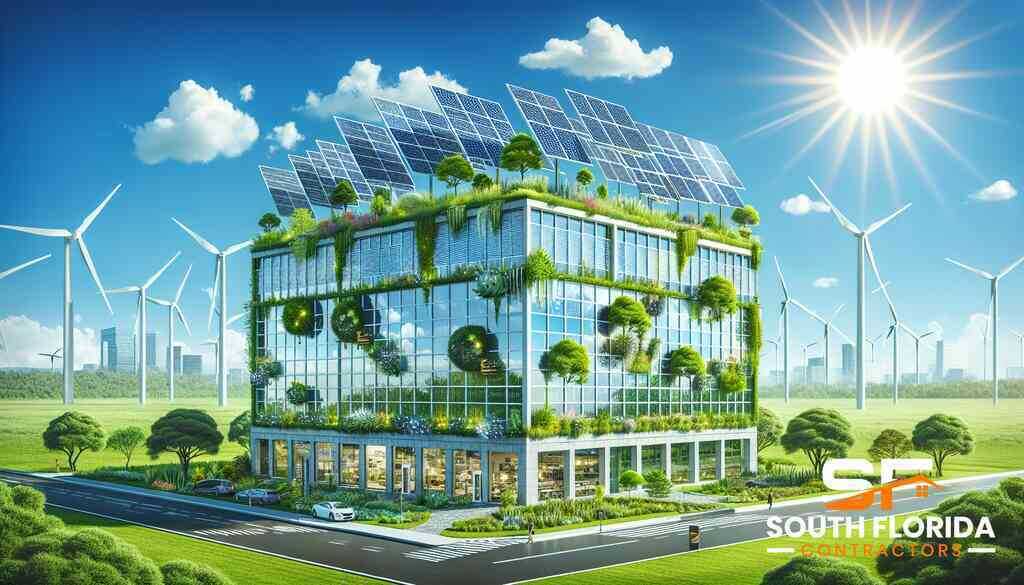
Best Practices for Green Building in South Florida
August 19, 2024
Introduction to Green Building in South Florida
The importance of sustainable construction in South Florida
Sustainable construction in South Florida is no longer a niche market or an optional luxury; it’s a crucial movement towards ensuring the region’s long-term livability and resilience. What Is Green Building in South Florida Homes? Facing unique environmental challenges, including rising sea levels and frequent hurricanes, South Florida’s construction industry has recognized the imperative need for greener building practices. Sustainable construction not only aims to minimize environmental impact through efficient use of resources but also ensures buildings are more durable and resilient against the harsh climate conditions prevalent in the area. Embracing green building practices is essential for the well-being of the community, the integrity of our ecosystems, and the preservation of South Florida’s natural beauty for future generations.
The rise of eco-friendly building practices
In recent years, South Florida has seen a significant surge in eco-friendly building practices. This rise is driven by a growing awareness among homeowners, builders, and developers about the benefits of adopting sustainable construction methods. Factors such as energy conservation, water efficiency, and the use of non-toxic materials are becoming increasingly important considerations in the planning and development of new projects. The push towards green building has also been supported by advancements in technology and materials, making sustainable options more accessible and cost-effective than ever before. Furthermore, regulatory frameworks and incentives have started to favor green initiatives, encouraging more projects to consider environmental impact in their design and execution.
Understanding the basics of green building standards in South Florida
Green building standards are crucial for guiding the construction industry towards sustainability. In South Florida, these standards revolve around optimizing energy use, reducing water consumption, selecting sustainable materials, and improving indoor air quality. One widely recognized framework is the Leadership in Energy and Environmental Design (LEED), which provides a comprehensive set of criteria covering all aspects of green construction. These standards ensure that buildings are designed, constructed, and operated in an environmentally responsible manner. Understanding these basics is vital for anyone involved in the construction industry, from architects and builders to homeowners aspiring to make their properties as eco-friendly as possible. As South Florida continues to evolve, these green building standards play a pivotal role in shaping a sustainable urban landscape that can thrive amidst the challenges posed by climate change and urbanization.
Critical Elements of Green Construction in South Florida
Material selection: The role of green construction materials in South Florida
In South Florida, the choice of construction materials plays a pivotal role in defining the sustainability and efficiency of a building. Opting for eco-friendly construction materials in South Florida not only supports the environment by reducing carbon footprint but also contributes to the health and well-being of the occupants. Sustainable materials like bamboo, recycled steel, and low-emission glass are not only durable against harsh climate conditions but also offer superior performance. Using these materials can significantly reduce the maintenance and energy costs over time. Furthermore, South Florida contractors are now prioritizing materials sourced locally, which helps support the local economy and reduce transportation emissions, embodying a holistic approach to green building.
Energy Efficiency: The importance of energy-efficient buildings and windows in South Florida
Energy efficiency is a cornerstone of green building practices in South Florida, where the climatic conditions demand high use of air conditioning and ventilation systems. Implementing energy-efficient designs and technologies, such as high-performance HVAC systems and energy-efficient buildings in South Florida, significantly reduces the energy demand of buildings. Special attention is also given to window design, incorporating double-glazing and UV-reflecting coatings to minimize heat gain and loss. Such measures not only lower the carbon footprint but also ensure substantial savings on utility bills. Leveraging innovative technology and automation in buildings for intelligent energy management further underlines the commitment to sustainability in the region’s construction sector.
Water conservation: Incorporating water-efficient fixtures and rainwater harvesting in South Florida
Water conservation techniques are crucial in South Florida’s green building initiatives, given the region’s susceptibility to drought conditions and the importance of preserving its precious freshwater resources. The integration of water-efficient fixtures, such as low-flow toilets and showerheads, alongside the adoption of rainwater collection systems in South Florida, can significantly reduce water usage in residential and commercial buildings. These systems not only supply non-potable water for irrigation, cooling, and toilet flushing but also help mitigate flood risks by reducing runoff. Efficient irrigation methods, such as drip irrigation and native xeriscaping, complement these efforts by minimizing outdoor water use without compromising aesthetic appeal.
Innovations in sustainable landscaping with native vegetation
Sustainable landscaping is an integral part of green building in South Florida, emphasizing the use of native plants and trees that are well-adapted to the local climate and soil conditions. These landscaping strategies reduce the need for chemical fertilizers and excessive watering, thereby supporting biodiversity and preventing harmful runoff into waterways. Advancements in landscaping also introduce innovative ecological solutions, such as green walls and roofs, which contribute to cooling buildings naturally, improving air quality, and enhancing urban biodiversity. Sustainable landscaping with native plants in South Florida offers a model for future development, where functional, aesthetic, and environmental benefits converge, fostering a healthier relationship between built and natural environments.
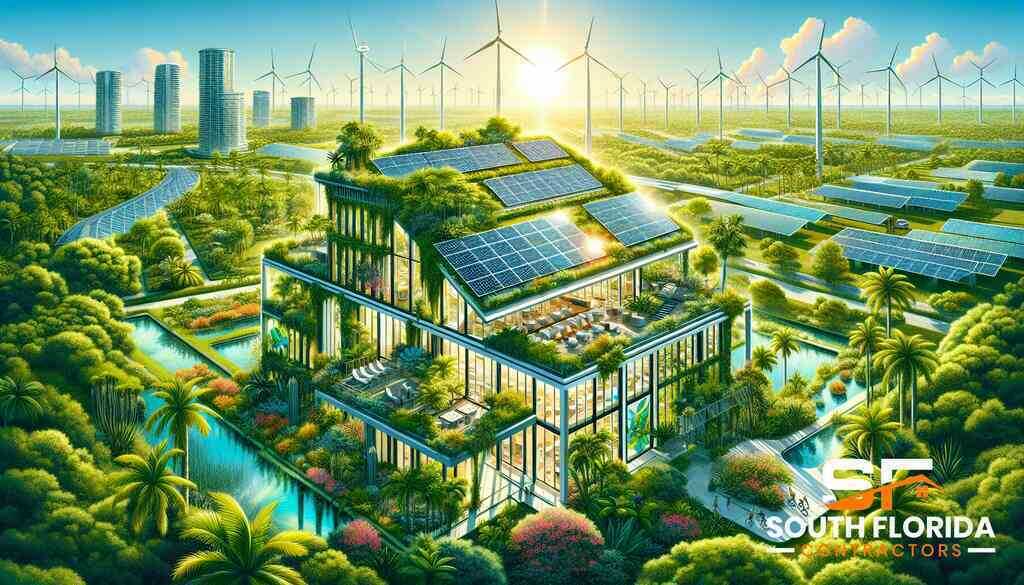
Technologies and Strategies for Eco-friendly Buildings
Solar Energy Implementation in South Florida
The adoption of solar energy in South Florida is a shining example of how modern technology can be harnessed to create sustainable, eco-friendly buildings. With the region’s abundance of sunshine, installing photovoltaic panels on homes and commercial properties has become an increasingly popular strategy for reducing reliance on non-renewable energy sources. This shift towards solar power not only lowers energy bills but also significantly reduces the carbon footprint of buildings. Innovative solar technologies, such as transparent solar cells, are being integrated into windows and facades, offering new avenues for solar energy harvesting without compromising architectural aesthetics. Moreover, the availability of solar power usage in South Florida homes reflects a growing trend that blends technology with sustainability to meet the energy demands of the 21st century.
Geothermal heating advantages in tropical climates
In the quest for sustainable heating and cooling solutions, geothermal technology stands out for its efficiency, especially in regions with tropical climates like South Florida. This technology taps into the earth’s stable underground temperature to heat and cool buildings, drastically reducing energy consumption compared to traditional HVAC systems. Geothermal heating and cooling systems circulate water through underground pipes, leveraging the constant temperatures below the Earth’s surface to provide comfortable indoor environments year-round. This method not only generates significant savings on utility bills but also contributes to a substantial decrease in greenhouse gas emissions. Geothermal heating’s low maintenance and durability further underscore its advantages for eco-friendly construction in tropical climates, making it a cornerstone for future green buildings in South Florida.
Utilizing low-VOC materials for healthier indoor environments
The focus on creating healthier indoor environments in South Florida’s green buildings has led to a significant shift towards using low-volatile Organic Compound (VOC) materials. VOCs are chemicals found in many traditional building materials, from paints and sealants to flooring and adhesives, which can release toxic emissions into the air over time. Low-VOC alternatives provide a safer option, contributing to better air quality and reducing health risks to occupants. These materials are part of a broader commitment to environmental responsibility and occupant health in green building practices, ensuring that homes and workplaces are not only energy-efficient but also safe and comfortable living spaces. By prioritizing eco-friendly insulation solutions in South Florida, the green construction industry is leading the way in reducing indoor air pollution and fostering well-being.
Advantages of green roofing and passive solar design for cooling
Green roofing and passive solar design represent two innovative strategies that have been gaining traction in South Florida’s sustainable construction sector. Green roofs, covered with vegetation, act as insulating layers that reduce heat absorption, thereby lowering the temperature inside buildings and decreasing the need for air conditioning. This not only results in energy savings but also mitigates the urban heat island effect, contributing to more relaxed city environments. On the other hand, passive solar design uses the building’s orientation, window placement, and materials to maximize natural light and warmth during winter while minimizing heat gain during summer. Together, these strategies enhance building efficiency, promote environmental sustainability, and offer economic benefits through reduced energy costs, showcasing the multifaceted advantages of eco-friendly building practices in South Florida.
Renewable energy integration and green building incentives in South Florida
Integrating renewable energy into South Florida’s building infrastructure is a critical component of the region’s green building movement. This initiative is not only about adopting solar or geothermal systems but also about creating a framework where renewable energy sources power a significant portion of the building’s needs. Incentives, such as tax credits, rebates, and grants, play a crucial role in encouraging homeowners, developers, and businesses to invest in renewable technologies. These incentives, combined with regulatory support for renewable energy integration, underscore South Florida’s commitment to reducing its carbon footprint and leading by example in the fight against climate change. Through initiatives like these, South Florida is paving the way for a more sustainable and environmentally conscious construction industry.
Planning and Implementing Sustainable Construction Projects
The process of achieving LEED certification in South Florida
Achieving LEED certification guidance in South Florida symbolizes a solid commitment to sustainability and energy efficiency in the building industry. The process involves comprehensive planning from the project’s inception, focusing on innovative strategies to reduce environmental impact. For a project in South Florida, this means integrating elements such as high-efficiency HVAC systems, sustainable materials, and water conservation techniques. Collaboration with architects, engineers, and contractors who are experienced in LEED projects is crucial. They can guide the design and construction phases to ensure all LEED criteria are met or exceeded. Furthermore, documentation and verification of all sustainable practices are critical steps in the certification process, highlighting the project’s adherence to the highest green building standards.
Conducting energy audits for existing structures
Energy audits play a pivotal role in identifying opportunities for improving efficiency in existing structures. These audits offer a detailed analysis of how buildings consume energy, pinpointing areas where modifications can lead to significant savings and environmental benefits. In South Florida, conducting an energy audit involves assessing air conditioning systems, insulation, lighting, and other critical energy-related aspects. Recommendations may include upgrading to energy-efficient appliances, sealing leaks, or adding insulation. Implementing these changes not only reduces the carbon footprint but also enhances the comfort and value of the property. Moreover, energy audits are a critical first step for buildings seeking to achieve LEED certification, laying the foundation for a systematic approach to sustainability.
Tips for sourcing reclaimed materials for construction projects
Sourcing reclaimed materials is a cornerstone of sustainable construction, offering both environmental and aesthetic benefits. For South Florida contractors, using reclaimed wood, metal, glass, and even plastics can significantly reduce the demand for virgin resources and minimize waste. Essential tips include establishing relationships with local demolition companies and material reclaim centers to secure a steady supply of quality materials. Additionally, exploring online marketplaces and auctions can unearth unique finds. When selecting reclaimed materials, verifying their safety and suitability for the intended use is essential. This practice not only contributes to a project’s green credentials but also adds character and history to the final construction, embodying eco-friendly principles in every aspect.
Collaborating with green building consultants in South Florida
Collaboration with green building consultants is invaluable for projects aiming for sustainability and efficiency. These specialists bring a wealth of knowledge and experience in green practices, helping to navigate the complexities of eco-friendly construction. In South Florida, working with consultants means gaining insights into the most appropriate materials, technologies, and designs suited to the local climate and environmental challenges. They can also assist with the LEED certification process, energy audits, and the integration of renewable energy systems. Establishing a partnership with these experts ensures that every aspect of the project aligns with the highest standards of sustainability, from initial planning to final implementation.
South Florida Contractors’ role in promoting green building practices
South Florida Contractors are at the forefront of transforming the construction landscape by advocating for and implementing green building practices. Their role is crucial in promoting sustainability across projects, whether new constructions or renovations. By prioritizing energy efficiency, sourcing eco-friendly materials, and incorporating innovative technologies like solar and geothermal systems, these contractors set new benchmarks for the industry. Their expertise and dedication to green principles not only improve the environmental footprint of their projects but also enhance community awareness and appreciation for sustainable development. As champions of eco-friendly construction, South Florida Contractors lead by example, demonstrating that building for the future means building green.
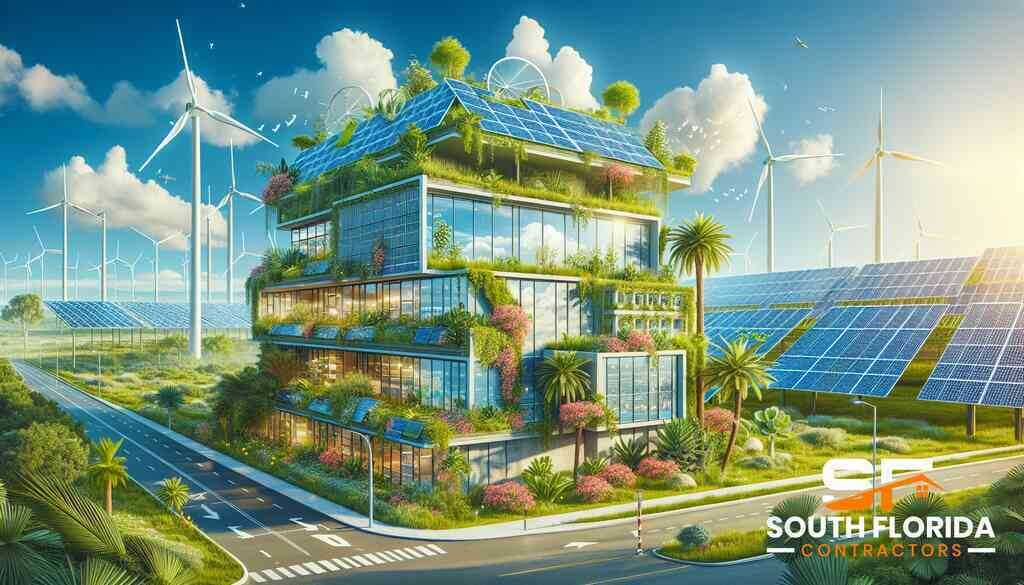
Future Trends and Developments in Green Building
Zero-energy buildings and their feasibility in South Florida
Zero-energy buildings (ZEBs) represent a revolutionary step forward in South Florida’s architectural landscape. ZEBs are designed to generate as much energy as they consume over a year, primarily through renewable resources like solar and wind power. In South Florida, the feasibility of ZEBs is exceptionally high due to the region’s generous sunlight, making solar energy a reliable and prolific energy source. Implementing ZEBs requires careful planning and the integration of advanced technologies, from high-efficiency HVAC systems to state-of-the-art insulation materials that minimize energy loss. The movement towards zero-energy buildings in South Florida not only aligns with global sustainability goals but also promises significant long-term savings for property owners by slashing utility costs and ensuring energy independence.
The growing importance of sustainable development and construction
In recent years, sustainable development and construction have taken center stage in South Florida’s urban planning and real estate development discussions. This growing importance is driven by a collective understanding of the need to mitigate climate change effects, such as rising sea levels and intensified storm activities that particularly impact the region. Sustainable development initiatives within South Florida emphasize resilience, with projects that are designed to withstand extreme weather while minimizing environmental impact. More developers and homeowners are now prioritizing green building certifications, energy-efficient designs, and eco-friendly materials, recognizing that sustainable construction not only benefits the environment but also enhances property values and community well-being. The emphasis on sustainability is transforming the construction landscape, leading to healthier living environments and a robust approach to urban development.
Emerging green insulation technologies
Green insulation technologies are pivotal in South Florida’s ongoing transition to eco-friendly building practices. What is the Best Insulation Type for Delray Homes? Emerging innovations in insulation are set to redefine how buildings are protected from the extreme heat typical of the region. Among these advances, materials such as sheep’s wool, recycled denim, and aerogel offer superior insulation with minimal environmental footprint. These materials are not only efficient in terms of thermal regulation but also contribute to healthier indoor air quality by reducing reliance on synthetic materials that can emit harmful volatile organic compounds. As South Florida continues to embrace green building, these emerging insulation technologies are expected to play a critical role in achieving energy efficiency and sustainability targets, ultimately making homes and businesses more comfortable, affordable, and environmentally responsible.
The potential of smart cities and IoT in enhancing building efficiency
The integration of smart city technologies and the Internet of Things (IoT) heralds a new era in enhancing building efficiency across South Florida. 2024 Guide to Smart Home Systems in Boca Raton IoT devices can monitor and control building systems in real-time, from lighting and HVAC to security, optimizing energy use and reducing waste. When combined with smart city infrastructure, IoT-enabled buildings can communicate data to a centralized system, further streamlining energy consumption across entire urban areas. This networked approach not only improves efficiency but also enhances the resilience of buildings against climate-related challenges unique to South Florida. As more municipalities invest in innovative city technologies, the potential for IoT to revolutionize green building practices is immense, promising more sustainable, livable, and adaptive urban environments for future generations.
Conclusion: Building a Sustainable Future in South Florida
The Cumulative Impact of Green Building Practices
The cumulative impact of green building practices in South Florida cannot be overstated. By integrating sustainable materials, energy-efficient designs, and eco-friendly technologies, we are not only reducing our carbon footprint but also enhancing the resilience of our structures against climate change and natural disasters. Green building practices lead to significant energy savings, water conservation, and healthier indoor environments, thus contributing to a more sustainable and prosperous future for the entire region. As these practices gain momentum, they set a precedent for other areas to follow, showcasing how environmental stewardship and innovative construction can go hand in hand.
Encouraging Community and Industry Collaboration
To further the reach and effectiveness of green building practices, it is crucial to encourage collaboration between communities, the construction industry, policy-makers, and educational institutions. Community involvement ensures that sustainable development aligns with the needs and values of the residents. At the same time, collaboration with industry experts and policy-makers can lead to the formulation of supportive regulations, incentives, and educational programs. South Florida construction management and academic institutions can play pivotal roles in researching new technologies and methodologies, spreading awareness, and training the next generation of green builders. Through such partnerships, the principles of sustainable construction can become deeply rooted in South Florida’s culture, leading to widespread adoption and innovation.
The Pivotal Role of South Florida Contractors in Sustainable Construction
South Florida Contractors hold a critical position in the movement toward a greener future. As the ones who bring architectural visions to life, they have the power and responsibility to incorporate sustainable practices at every level of the construction process. From choosing eco-friendly materials to implementing energy-efficient systems, contractors are the key to transforming standard buildings into models of sustainability. Their commitment to green building not only enhances the livability and eco-friendliness of South Florida’s built environment but also inspires others in the industry to adopt similar practices. By continuing to champion sustainability, South Florida Contractors can lead a construction renaissance that prioritizes not just aesthetic and functional excellence but environmental stewardship as well.
In conclusion, as South Florida faces the pressing challenges of climate change and rapid urbanization, green building practices emerge as a beacon of hope and innovation. By embracing these practices, the region can ensure its growth is sustainable, resilient, and beneficial for all. Encouraging community and industry collaboration while recognizing the pivotal role of contractors will be essential in building a future where the harmony between human habitation and the natural environment is preserved and nurtured. South Florida’s journey toward sustainable construction is not just about building greener structures; it’s about crafting a legacy of environmental responsibility and resilience for generations to come.
Frequently Asked Questions
Question: What makes South Florida Contractors the best choice for sustainable construction projects in South Florida?
Answer: South Florida Contractors stands at the forefront of sustainable construction in South Florida, thanks to our profound commitment to eco-friendly building practices and our extensive network of experienced green building consultants. We specialize in utilizing green construction materials, energy-efficient buildings, and innovative strategies like solar energy and rainwater harvesting not only to meet but exceed green building standards. Our dedication to advancing South Florida green building initiatives, coupled with our expertise in LEED certification processes, makes us the ideal partner for any project aiming to enhance environmental stewardship while ensuring resilience and efficiency.
Question: How can South Florida Contractors help in achieving LEED certification for green building projects?
Answer: South Florida Contractors plays a pivotal role in navigating the LEED certification process for green building projects in South Florida, leveraging our in-depth knowledge and professional collaborations. Our team works closely with certified green building consultants to integrate sustainable construction practices, from selecting low-VOC materials to implementing advanced energy-efficient technologies and passive solar design. This comprehensive approach ensures that projects not only meet but also surpass the stringent criteria set by the LEED framework, securing certification and demonstrating our unwavering commitment to promoting sustainable construction in the region.
Question: What innovative technologies and practices do South Florida Contractors incorporate to promote eco-friendly building practices in South Florida?
Answer: Embracing the latest in innovative technologies and best practices, South Florida Contractors integrates solar energy, geothermal heating, green roofing, and passive solar design into our projects to promote eco-friendly building practices in South Florida. Our focus on renewable energy integration, along with the use of sustainable landscaping with native vegetation and the implementation of energy-efficient windows, ensures that each project not only contributes to a greener environment but also offers enhanced living conditions and energy savings. Our commitment to innovation, combined with our expertise in sourcing reclaimed materials and employing the latest green insulation technologies, positions us as leaders in the transition towards more sustainable construction practices in the region.
Question: How do South Florida Contractors contribute to the advancement of South Florida’s sustainable development and green building practices?
Answer: South Florida Contractors is committed to driving the advancement of sustainable development and green building practices within South Florida by adopting a holistic approach to construction. We firmly believe in the power of collaboration, working alongside community members, policy-makers, and industry experts to foster an environment that prioritizes eco-friendly construction. Our projects consistently showcase the benefits of energy audits, water-efficient fixtures, and the careful selection of eco-friendly building materials. By also focusing on educational outreach and leveraging our expertise in the latest sustainable technologies and standards, we aim to set new benchmarks for what is possible in green construction, making lasting contributions towards a greener, more sustainable South Florida. You can also visit our blog on Ultimate Review of South Florida Plumbing Services
Question: In the blog “Best Practices for Green Building in South Florida,” how do South Florida Contractors ensure the use of eco-friendly construction materials and techniques?
Answer: As discussed in the blog “Best Practices for Green Building in South Florida,” South Florida Contractors ensures the use of eco-friendly construction materials and techniques by meticulously sourcing materials that are both sustainable and locally produced, thereby reducing the carbon footprint of our projects. We champion the use of innovative materials like bamboo, recycled steel, and low-emission glass and implement cutting-edge technologies such as high-performance HVAC systems and intelligent energy management solutions. Our comprehensive approach also extends to water conservation through the installation of rainwater harvesting systems and the adoption of water-efficient fixtures, underlining our commitment to not only meet but exceed green building standards in South Florida.
